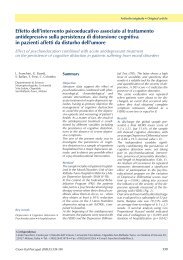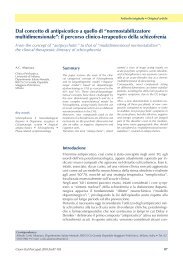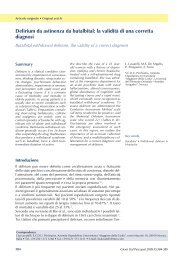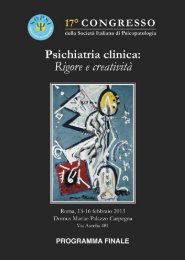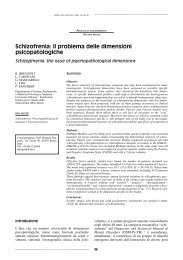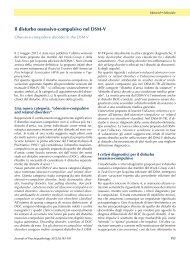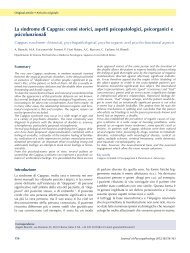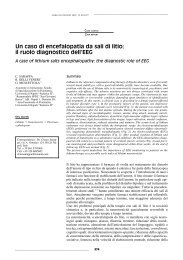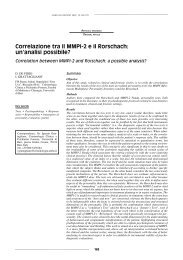XI Congresso della Società Italiana di Psicopatologia Psichiatria ...
XI Congresso della Società Italiana di Psicopatologia Psichiatria ...
XI Congresso della Società Italiana di Psicopatologia Psichiatria ...
Create successful ePaper yourself
Turn your PDF publications into a flip-book with our unique Google optimized e-Paper software.
SIMPOSI TEMATICI<br />
clinica dei farmaci antipsicotici <strong>di</strong> seconda generazione<br />
(“atipici”). Questi farmaci, sintetizzati nella speranza <strong>di</strong> trovare<br />
composti efficaci quanto la clozapina ma senza analoghi<br />
effetti collaterali, hanno rivoluzionato l’approccio terapeutico<br />
a molti <strong>di</strong>sturbi psichiatrici.<br />
Si è registrato un drammatico scarto tra i dati empirici raccolti<br />
negli stu<strong>di</strong> controllati, randomizzati, in doppio cieco,<br />
condotti principalmente a scopo <strong>di</strong> registrazione, e la pratica<br />
clinica corrente. In particolare, per tutti questi farmaci è<br />
stato proposto in fase <strong>di</strong> lancio sul mercato, sulla base dei<br />
dati degli stu<strong>di</strong> registrativi, un dosaggio che nel corso <strong>di</strong> alcuni<br />
mesi <strong>di</strong> pratica clinica si è <strong>di</strong>mostrato drammaticamente<br />
inadeguato.<br />
Il risperidone è stato inizialmente raccomandato al dosaggio<br />
quoti<strong>di</strong>ano <strong>di</strong> 8-16 mg, mentre la successiva pratica clinica<br />
ha spostato il range ideale <strong>di</strong> dosaggio quoti<strong>di</strong>ano a 2-6 mg.<br />
Per l’olanzapina è stato inizialmente raccomandato un ideale<br />
dosaggio quoti<strong>di</strong>ano <strong>di</strong> 10 mg, mentre la successiva pratica<br />
clinica ha evidenziato che il dosaggio quoti<strong>di</strong>ano ideale<br />
per la maggior parte dei pazienti con sintomi psicotici è <strong>di</strong><br />
20 mg/<strong>di</strong>e, e che per un numero significativo <strong>di</strong> pazienti sono<br />
necessari dosaggi più alti per un’ottimale risposta terapeutica.<br />
La quetiapina, inizialmente raccomandata alla dose <strong>di</strong> 300<br />
mg/<strong>di</strong>e in fase acuta, è ora raccomandata dalla stessa azienda<br />
produttrice a dosaggi quoti<strong>di</strong>ani non inferiori a 600 mg,<br />
ed è pratica clinica non rara impiegarla a dosaggi fino a ≥ 6<br />
volte maggiori alla dose inizialmente raccomandata.<br />
Il sertindolo, in<strong>di</strong>cato inizialmente ad una dose quoti<strong>di</strong>ana<br />
<strong>di</strong> 8-24 mg, è stato presto ritirato dal commercio e non è stato<br />
forse possibile valutarne adeguatamente il dosaggio ideale<br />
nella pratica clinica corrente.<br />
Il dosaggio ottimale <strong>di</strong> amisulpride, in<strong>di</strong>cato dall’azienda<br />
produttrice sulla base degli stu<strong>di</strong> registrativi, è stato oltremodo<br />
variabile (e non poco confondente per gli psichiatri),<br />
oscillando da 50 mg (nella improbabile in<strong>di</strong>cazione antidepressiva)<br />
a 100-300 mg (nella dubbia in<strong>di</strong>cazione <strong>di</strong> trattamento<br />
dei cosiddetti sintomi negativi) ed a 600-1.200 mg<br />
nella più fondata in<strong>di</strong>cazione <strong>di</strong> trattamento dei sintomi psicotici<br />
positivi.<br />
L’aripiprazolo è stato lanciato con un’in<strong>di</strong>cazione <strong>di</strong> dosaggio<br />
ottimale giornaliero <strong>di</strong> 15-30 mg. Forse anche con questo<br />
farmaco è stato commesso un errore. Dosaggi molto inferiori<br />
si sono già rivelati ottimali in un numero significativo<br />
<strong>di</strong> pazienti.<br />
La clozapina sembra essere l’unico antipsicotico <strong>di</strong> nuova<br />
generazione in cui i dosaggi proposti in fase <strong>di</strong> lancio sono<br />
stati confermati dai successivi anni <strong>di</strong> pratica clinica. Ma oltre<br />
due decenni <strong>di</strong> uso pratico clinico <strong>di</strong> questo farmaco precedenti<br />
il rilancio registrativi ufficiale spiegano forse questa<br />
<strong>di</strong>fferenza.<br />
Prevention of suicidal behaviour in clinical<br />
trials and in practice<br />
Z. Rihmer<br />
National Institute for Psychiatry and Neurology, Budapest<br />
Since suicide in mood <strong>di</strong>sorder patients occurs almost exclusively<br />
in the context of major depressive episode or in<br />
dysphoric mania, to treat mood episodes effectively and to<br />
stabilize the period of euthymia is essential for suicide prevention.<br />
In fact, several large-scale, naturalistic, observational,<br />
long-term clinical follow-up stu<strong>di</strong>es (inclu<strong>di</strong>ng mostly severely<br />
ill, frequently suicidal unipolar or bipolar inpatients)<br />
show that compared to no treatment, the risk of completed<br />
suicide of patients on long-term me<strong>di</strong>cation (mood stabilizers<br />
and/or antidepressants) is 2-8 fold lower.<br />
On the other hand, however, the meta-analyses of phase 2-<br />
3 RCTs on unipolar major depression shows almost a double<br />
frequency of suicidal behaviour of patients on antidepressants,<br />
compared to those on placebo.<br />
This is in sharp contrast with the 2-8 fold reduction of sucidal<br />
risk among treated vs. untreated mood <strong>di</strong>sorder patients,<br />
reported in open clinical trials.<br />
The possible explanation of this contra<strong>di</strong>ction might be that<br />
in contrast to “officially” <strong>di</strong>agnosed Bipolar I and Bipolar II<br />
depressives, as well as the actively suicidal/psychotic depressives,<br />
subthreshold bipolar/bipolar spectrum patients<br />
are not excluded from the randomized controlled antidepressant<br />
trials on “unipolar” major depression, and as we<br />
have learnt recently, antidepressant monotherapy (unprotected<br />
by mood stabilizers) can induce/worsen depressive<br />
mixed states even in subthreshold bipolar and bipolar spectrum<br />
depressives.<br />
References<br />
Akiskal HS, et al. J Affect Disord 2005;85:245-58.<br />
Angst F, et al. J Affect Disord 2002;68:167-81.<br />
Kahn A, et al. Am J Psychiat 2003;160:790-2.<br />
Yerevanian BI, et al. Acta Psychiat Scand 2004;110:452-8.<br />
Treatment of depression in controlled trials<br />
vs. clinical practice<br />
F. Benazzi<br />
University of California, San Diego and Hecker Psychiatry<br />
Research Center, Forli<br />
Introduction: the current best evidence based on controlled<br />
trials of depression is not seen by clinicians as relevant for<br />
clinical practice (March et al., Am J Psychiatry 2005). Practical<br />
clinical trials have been suggested, to overcome the<br />
limitations of controlled trials.<br />
While controlled trials include very selected populations<br />
not representative of usual clinical practice (and may have<br />
several biases related to the fun<strong>di</strong>ng by drug companies),<br />
practical clinical trials include usual clinical practice populations,<br />
the setting is clinical practice, simple and clinically<br />
relavant outcomes are assessed, selection bias and<br />
confoun<strong>di</strong>ng are controlled by random treatment assignment.<br />
Methods: several antidepressant controlled trials were reviewed,<br />
and compared to usual clinical practice.<br />
The focus was mainly on the treatment of bipolar depression.<br />
Results: nonbipolar depressed in<strong>di</strong>viduals who would qualify<br />
for an antidepressant efficacy trial were compared to<br />
nonbipolar depressed in<strong>di</strong>viduals not qualifying for an antidepressant<br />
clinical trial. Nonqualifying in<strong>di</strong>viduals were<br />
132




